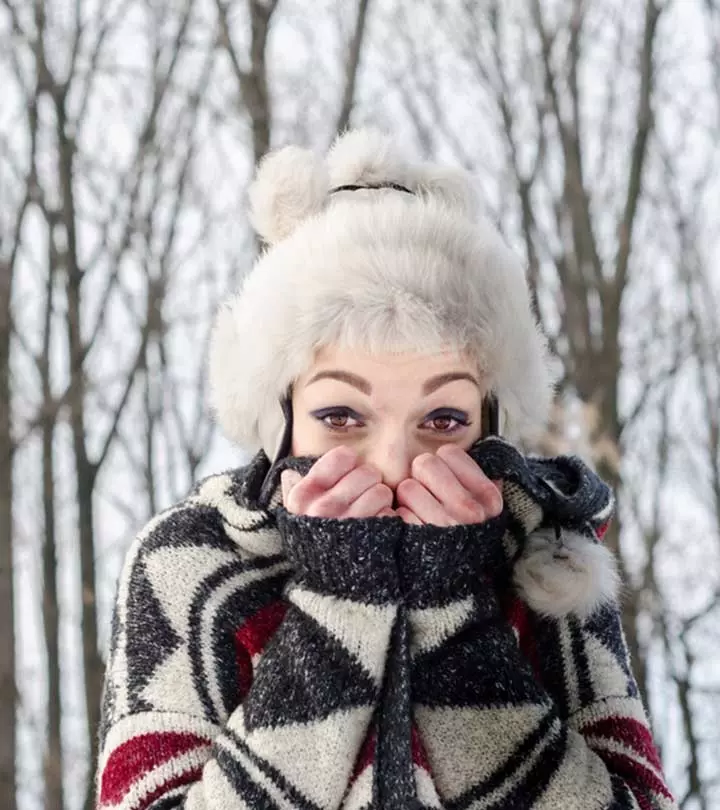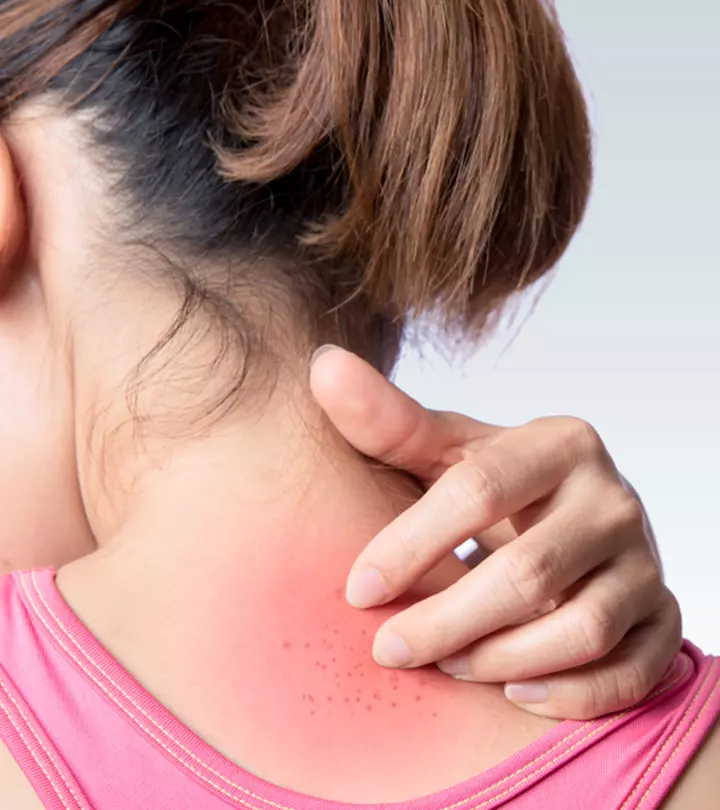Ice Burn: Causes, Symptoms & 11 Home Treatment Tips
Educate yourself on the symptoms, risk factors, diagnosis, and treatments for these burns.

Image: Shutterstock
Just like getting too close to a flame can burn you, ice can also do the same. That’s right; you can get burned by ice! But no need to be alarmed. By following a few precautions and observing potential symptoms, you can effectively deal with it. Ice burns occur when ice or other cold, frozen objects come into prolonged contact with your skin. These burns can vary in degree from mild numbness and redness to severe cases where your tissues can get completely damaged. This article dives deep into the causes, symptoms, and risk factors of ice burns while also offering practical tips and treatment solutions to effectively manage it. Keep reading to learn more!
 Fun Fact
Fun FactIn This Article
What Causes Ice Burns?

Putting ice or anything frozen on your skin for an extended period (several minutes) may cause frostbite. This occurs as ice crystals form within the skin cells, restricting the blood flow and damaging the cells. This can cause severe tissue damage and even necrosis if not treated properly. Applying ice for a longer period can also deplete the oxygen supply in the surrounding tissues, damaging deep skin layers and causing an ice burn. In that case, the only solution is to visit a doctor immediately.
Some of the factors that lead to ice burns are:
- Long-term exposure to freezing temperatures.
- Exposure to cold winds and high altitudes.
- Taking part in winter activities.
Homeless people living in very cold areas are particularly prone to ice burns.
A study was conducted to understand the incidence and target population of frostbite, which eventually leads to worse conditions like amputations. This study determined that 20% of frostbite patients are disabled due to amputations and belong to the homeless population. The overall incidence of frostbite injury was 0.83 out of 100,000 people in the US.
 Trivia
TriviaBut how can you confirm that you have an ice burn? To figure that out, you need to know the symptoms of ice burns to look out for. Check them out below.

Key Takeaways
- Ice burns occur when ice or other cold objects come in prolonged contact with your skin.
- Skin discoloration, blisters, hard or waxy skin are some of the symptoms of ice burn.
- Young children and the elderly are vulnerable to ice burns due to their thin and fragile skin.
What Are The Symptoms Of An Ice Burn?

The symptoms of an ice burn include:
- Numbness
- Tingling sensation
- Itchiness
- Pain
- Skin discoloration
- Blisters
- Hard or waxy skin reaction
The appearance of an ice burn depends on its severity. Learn the details in the next section.
What Does An Ice Burn Look Like?
An ice burn or frostbite looks very similar to a regular burn, depending on its severity, rated in degrees.
- First-Degree Frostbite: There may be a numbness or a tingling sensation in the area, which may appear red.
- Second-Degree Frostbite: The area appears white or pale, and there may be some blistering and hardening of the skin.
- Third-Degree Frostbite: The area may turn blue or purple, and there can be severe damage to the skin, tissues, and blood vessels. In extreme cases, there may be tissue death.
While less serious ice burns resolve by themselves in a few days or weeks with gentle care, severe cases may require medical treatment, even surgery, for prompt recovery.
Regardless of the degree of the ice burn, it is ideal to get a medical diagnosis when you experience it.
Wondering how a doctor diagnoses ice burns? Find out below.
How Are Ice Burns Diagnosed?

If your skin remains pale/white, cold, and firm even after removing the cold object, or if it is numb and does not regain its color even after warming up – it could be an ice burn. Consult a doctor, who will determine the severity of the burn and prescribe the appropriate treatment.
Rachel, an athlete, recounts her experience with ice burns on her blog. She recounts an incident from after icing her shins, sharing, “When I took them off, there were a couple spots that had gone really numb, but I figured they would just “thaw out” in a bit, so I hopped in the shower. Big mistake…I thought my skin was on fire! When I finished, I noticed that I now had massive red welts covering both lower legs. Today they are still very tender and have even blistered a bit (i).”
Learn who is at risk of getting ice burns in the following section.
Who Is At Risk Of Getting An Ice Burn?
Anyone can get an ice burn, but some people are at greater risk. For instance:
- People with medical conditions like diabetes, peripheral vascular disease, and peripheral neuropathyi A condition characterized by weakness and pain due to nerve damage in hands or feet due to diabetes, injuries, or any infection. are said to be at greater risk of frostbite and ice burns (1), (2).
- Young children and the elderly are particularly vulnerable to ice burns due to their thin and fragile skin.
- People who have a habit of smoking are vulnerable to frostbite and ice burns (2), (3).
Conducting some first aid immediately after getting an ice burn can help your injury to heal well.
Learn more in the next section.
How Are Ice Burns Treated?

Most ice burns can be treated at home. However, you must take a few steps to avoid greater damage from ice burns. Here are some common home remedies for burns (4):
- Remove the injury-causing item.
- Remove wet clothes.
- Avoid touching the affected area to prevent further harm.
- Take an over-the-counter pain reliever.
- Warm compresses or blankets can be used to help you relax. Avoid rubbing the wounded area or applying direct heat, as the area will be numb and may burn quickly.
- Place the affected area in a bath of warm water (37–39°C) for 30 minutes to 1 hour.
- If the skin is still cold, continue the warm water soak.
- Remove unwanted debris from the affected skin.
- Apply a soothing ointment, such as aloe vera. You can use aloe vera for burns, as it cools and heals the skin.
- Protect the burned skin area with a bandage.
- Apply a soothing compress made of natural ingredients such as honey or chamomile to alleviate burning sensations and promote skin healing.
- Drink plenty of water to avoid dehydration.
Depending on the condition of the wound, you may need to use chemical pain relievers, antibiotic ointments, and bandage dressing.
If the ice burn does not heal after at-home treatment, seek medical help for further diagnosis and treatment.
Also, seek medical attention if the ice burn starts looking infected. The doctor may prescribe antibiotics to treat it (4).
For severe frostbite wounds, thrombolytici A therapy that dissolves highly risky blood clots and improves blood flow to prevent heart attack and stroke. /prostacyclini A circulating hormone released by the lungs into the arterial circulation (blood flow to the heart) to maintain normal blood pressure. therapy may be considered (4).
Now, let’s talk about how long it takes for an ice burn to heal.
How Long Do Ice Burns Take To Heal?
It depends on the severity of the injury. For example, normal ice burns can heal in a matter of days, but severe burns can take months to heal completely and may require surgery to remove dead skin and tissue.
That is why it is better to prevent ice burns in the first place. Learn how to do so in the next section.
How Do You Prevent Ice Burns?
Here are a few precautions to follow to prevent ice burns:
- The best way to prevent ice burns is to always wear multiple layers of thermals and solid warm clothes. This is especially important if you are going ice climbing, skiing, or other such activities in cold places.
- Do not apply a cold pack directly to the skin. Place a thick cloth or a towel between your skin and the ice pack.
- Limit applying a cold pack to your skin for a maximum of 15-20 minutes. Follow up with a warm-up session.
- Skip the cold pack treatment if you have severe skin problems such as allergies.
Find out when you should seek medical attention in the next section.
When Should You See A Doctor?

Consult a doctor if you have any of the following symptoms:
- Your skin is pale white, cold, and hard.
- Even after being warmed, the skin does not regain its original appearance.
- As your skin warms up, it remains numb and does not burn or tingle.
Infographic: Everything To Know About Ice Burns
Long-term exposure to ice and chilly winds can result in burns, blisters, and even numbness throughout your body. Typically, it doesn’t go away after using a warm cloth or taking a shower. For treatment, you would need to see a doctor. Don’t be intimidated, despite how overwhelming it may seem. If you get hurt, we’ll explain how to treat it and what to avoid doing to prevent it.
Read the infographics below to discover more about ice burns and how to avoid and treat them.
Some thing wrong with infographic shortcode. please verify shortcode syntax
Summing It Up
Ice or anything frozen can affect the oxygen supply to the tissues, resulting in severe damage to the skin and tissues. It may cause ice burns. Long-term exposure to cold temperatures, cold winds, and altitudes may cause ice burns. If you get an ice burn, you may experience pain, discoloration, numbness, tingling, blisters, or itchiness. Normally, it takes a few days to heal with at-home treatments. However, if your skin remains numb or hard even after following the remedies discussed here, seek immediate medical attention.
Frequently Asked Questions
Should I pop an ice burn blister?
No, you should not pop an ice burn blister, as it can get infected and slow down the healing process.
Why does frostbite turn black?
Frostbite turns the skin black due to tissue death in the affected area.
How long does frostbite last?
Frostbite usually heals within a few weeks unless there are complications. The skin recovers completely within 6 months.
Can an ice burn leave a scar?
Sometimes, yes, especially if the burn was deep or if you scratched or popped a blister.
What should I avoid putting on an ice burn?
Avoid putting things like hot water, alcohol-based products, or harsh creams on the affected area. They can further irritate the skin and slow down healing.
Can kids or elderly people get ice burns more easily?
Yes, kids and elderly people have more delicate skin. Ensure they have minimal contact with ice or frozen objects, and also be extra careful when using ice packs on them.
Illustration: Ice Burn: Causes, Symptoms, And Treatment

Image: Dall·E/StyleCraze Design Team
Looking for relief from ice burns? This video contains essential remedies and step-by-step guidance on how to effectively treat ice burns for a quicker recovery. Check it out!
Personal Experience: Source
StyleCraze's articles are interwoven with authentic personal narratives that provide depth and resonance to our content. Below are the sources of the personal accounts referenced in this article.
i. Ice Burnhttps://rachelmakesarunforit.blogspot.com/2010/01/ice-burn.html
References
Articles on StyleCraze are backed by verified information from peer-reviewed and academic research papers, reputed organizations, research institutions, and medical associations to ensure accuracy and relevance. Read our editorial policy to learn more.
- Diabetes and foot burns
https://www.ncbi.nlm.nih.gov/labs/pmc/articles/PMC6367851/ - The occurrence of frostbite and its risk factors in young men
https://pubmed.ncbi.nlm.nih.gov/15139242/ - Frostbite: epidemiology at high altitude in the Karakoram mountains
https://pubmed.ncbi.nlm.nih.gov/9623370/ - Cold burn injuries in the UK: the 11-year experience of a tertiary burns centre
https://www.ncbi.nlm.nih.gov/labs/pmc/articles/PMC5105282/#CR16
Read full bio of Dr. Somodyuti Chandra
Read full bio of Monomita Chakraborty
Read full bio of Anjali Sayee
Read full bio of Swathi E



























Community Experiences
Join the conversation and become a part of our empowering community! Share your stories, experiences, and insights to connect with other beauty, lifestyle, and health enthusiasts.